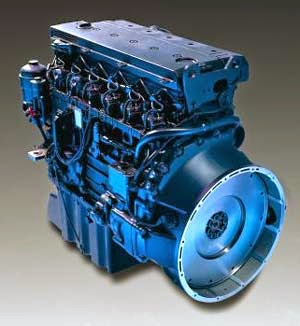Diesel
Engines vs. Gasoline Engines
In theory, diesel engines and gasoline engines are quite similar. They are
both internal combustion engines designed to convert the
chemical energy available in fuel into mechanical energy. This mechanical
energy moves pistons up and down inside cylinders. The pistons are connected to
a crankshaft, and the up-and-down motion of the pistons, known as linear
motion, creates the rotary motion needed to turn the wheels of a car forward.
Both diesel engines and gasoline engines
covert fuel into energy through a series of small explosions or combustions.
The major difference between diesel and gasoline is the way these explosions
happen. In a gasoline engine, fuel is mixed with air, compressed by pistons and
ignited by sparks from spark plugs. In a diesel engine, however, the air is
compressed first, and then the fuel is injected. Because air heats up when it's
compressed, the fuel ignites.
The diesel engine uses a four-stroke
combustion cycle just like a gasoline engine. The four strokes are:
·
Intake
stroke -- The intake
valve opens up, letting in air and moving the piston down.
·
Compression
stroke -- The piston
moves back up and compresses the air.
·
Combustion
stroke -- As the piston
reaches the top, fuel is injected at just the right moment and ignited, forcing
the piston back down.
·
Exhaust
stroke -- The piston
moves back to the top, pushing out the exhaust created from the combustion out
of the exhaust valve.
Remember that the diesel engine has no spark
plug, that it intakes air and compresses it, and that it then injects the fuel
directly into the combustion chamber (direct injection). It is the heat of the
compressed air that lights the fuel in a diesel engine. In the next section,
we'll examine the diesel injection process.
COMPRESSION
When working on his calculations, Rudolf Diesel theorized that
higher compression leads to higher efficiency and more power. This happens
because when the piston squeezes air with the cylinder, the air becomes
concentrated. Diesel fuel has a high energy content, so the likelihood of
diesel reacting with the concentrated air is greater. Another way to think of
it is when air molecules are packed so close together, fuel has a better chance
of reacting with as many oxygen molecules as possible. Rudolf turned out to be
right -- a gasoline engine compresses at a ratio of 8:1 to 12:1, while a diesel
engine compresses at a ratio of 14:1 to as high as 25:1.
Diesel Fuel Injection
One big difference between a diesel engine and
a gasoline engine is in the injection process. Most car engines use port
injection or a carburetor. A port injection system injects fuel just prior to
the intake stroke (outside the cylinder). A carburetor mixes air and fuel long
before the air enters the cylinder. In a car engine, therefore, all of the fuel
is loaded into the cylinder during the intake stroke and then compressed. The
compression of the fuel/air mixture limits the compression ratio of the engine
-- if it compresses the air too much, the fuel/air mixture spontaneously
ignites and causes knocking. Because it causes excessive heat,
knocking can damage the engine.
Diesel engines use direct fuel injection --
the diesel fuel is injected directly into the cylinder.
The injector on a diesel engine is its most
complex component and has been the subject of a great deal of experimentation
-- in any particular engine, it may be located in a variety of places. The
injector has to be able to withstand the temperature and pressure inside the
cylinder and still deliver the fuel in a fine mist. Getting the mist circulated
in the cylinder so that it is evenly distributed is also a problem, so some
diesel engines employ special induction valves, pre-combustion chambers or
other devices to swirl the air in the combustion chamber or otherwise improve
the ignition and combustion process.
Some diesel engines contain a glow
plug. When a diesel engine is cold, the compression process may not raise
the air to a high enough temperature to ignite the fuel. The glow plug is an
electrically heated wire (think of the hot wires you see in a toaster) that heats the combustion chambers and
raises the air temperature when the engine is cold so that the engine can
start. According to Cley Brother ton, a Journeyman heavy equipment technician:
All functions in a modern
engine are controlled by the ECM communicating with an elaborate set of sensors
measuring everything from R.P.M. to engine coolant and oil temperatures and
even engine
Photo courtesy Daimler Ate go six-cylinder diesel engine


Thanks for truck mechanical
ReplyDeleteinjector pump supplier in Agra
Nice stuff dear Car Leasing & Nissan Leasing
ReplyDelete